
Nederlandse Spoorwegen is the principal passenger railway operator in the Netherlands. It is a Dutch state-owned company founded in 1938. The Dutch rail network is the busiest in the European Union, and the third busiest in the world after Switzerland and Japan.

The HSL-Zuid, is a 125 kilometre-long Dutch high-speed rail line running between the Amsterdam metropolitan area and the Belgian border, with a branch to Breda, North Brabant. Together with the Belgian HSL 4 it forms the Schiphol–Antwerp high-speed railway. Originally scheduled to be in service by 2007, the first public operations began on 7 September 2009, after a ceremony on 6 September.

The NS Class 600 were a class of 65 shunting locomotives built by English Electric in England between 1950 and 1957 for Nederlandse Spoorwegen (NS). The first 10 were built at Dick, Kerr & Co, Preston and the remaining 55 at Vulcan Foundry, Newton-le-Willows. They are very similar to the British Rail Class 11. Twenty-three locomotives were later fitted with radio remote-control, and renumbered in the range 671–693.

The Nederlandse Spoorwegen (NS) Class 200 diesel locomotives were built for shunting duties. 169 of these small locomotives, numbered 201–369, were built by Werkspoor from 1934–1951. They were known as "Sik" by rail enthusiasts and "locomotor" by railway staff. Fifteen of these locomotives were rebuilt with a retractable crane. The few locomotives in active service were retired in 2008 after new Dutch personnel safety regulations prevented NS from using them any longer. Most were no longer active at that time.

The Railway Museum in Utrecht is the Dutch national railway museum. It was established in 1927 and since 1954 has been housed in the former Maliebaan station.
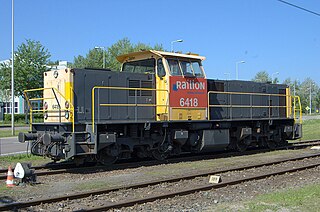
The NS Class 6400 is a type of Bo-Bo diesel-electric freight locomotive. 120 were built by MaK and ABB between 1988 and 1994 for Nederlandse Spoorwegen.

Rail transport in the Netherlands uses a dense railway network which connects nearly all major towns and cities. There are as many train stations as there are municipalities in the Netherlands. The network totals 3,223 route km (2,003 mi) on 6,830 kilometres (4,240 mi) of track; a line may run both ways, or two lines may run on major routes. Three-quarters of the lines have been electrified.

The Blue Angel was the name given to the Plan X class DE-1 and DE-2 diesel railcars formerly used by Nederlandse Spoorwegen. There have been rumours that the name has a connection to the German movie Der blaue Engel, but this has never been confirmed.

Class 11 is part of the large 1980s family of 144 electric locomotives. The family was made up of Classes 11 (12), 12 (12), 21 (60) and 27 (60). Classes 11, 12 and 21 were nearly twice as powerful as Classes 22, 23 and 25 while Class 27 was more than twice as powerful as these 1950s locomotives. This family was heavily influenced by the Class 20² from the mid-1970s. They were very reliable because of the trial and error development of their predecessor. This family came into service with M4 and M5 coaching stock and the AM 80 and AM 86 series of EMUs. This generation was a major modernization of the NMBS/SNCB even if the older M2 coaching stock remained active for more than a decade before being replaced. The only real difference between a Class 11 and a Class 21 was the Class 11 had a transformer inside to allow working under both 3000 V DC in Belgium and 1500 V DC plus Dutch signalling and train protection for working in Holland. Externally they were identical to Classes 12 and 21 aside from the livery and a few minor details.

The Nederlandse Spoorwegen (NS) Class 1200 was a class of electric locomotives that were in service from 1951 until 1998. They were designed by Baldwin and built by Werkspoor (Utrecht) between 1951 and 1953. The electrical equipment was built by N.V. Heemaf (Hengelo) to a design by Westinghouse. Some parts were made in the United States as part of the Marshall Plan.
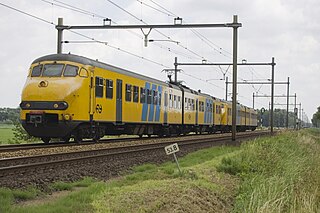
The NS Mat '64 or Materieel '64 were electric multiple units (EMU) built by Werkspoor and later by Duewag and Waggonfabrik Talbot between 1961 and 1976. They were operated in the Netherlands by the Nederlandse Spoorwegen (NS) until 2016. The equipment consisted of independent four and two-car train sets called Plan T and Plan V: the Plan T is a 4-car EMU, and the Plan V is a 2-car EMU. Materieel '64 is sometimes nicknamed 'Apekoppen' and 'Standaard Stoptrein' due to their distinct shape.
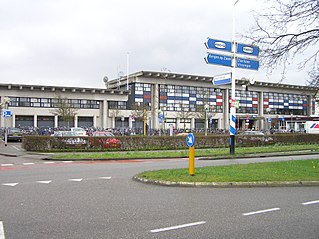
Goes is a railway station located in Goes, the Netherlands. The station was opened on 1 July 1868 and is located on the Roosendaal–Vlissingen railway. The station is operated by Nederlandse Spoorwegen (NS).

The Stadsgewestelijk Materieel or SGM was an electric multiple unit (EMU) train type that was operated by the Dutch railway company Nederlandse Spoorwegen. They were built from 1975 to 1983 by Talbot and retired from service between 2018 and 2021.

The DB Class 202, also commonly referred to under its manufacturers' designation Henschel-BBC DE2500, since it was only in experimental use and never purchased by the DB, is a class of diesel-electric locomotives designed for use on main and secondary lines for both passenger and freight trains.

Werkspoor N.V. was the shortened, and later the official name of the Nederlandsche Fabriek van Werktuigen en Spoorwegmaterieel. It was a Dutch machine factory, known for rolling stock, (ship) steam engines, and diesel engines. It was a successor of the company Van Vlissingen en Dudok van Heel, later named Koninklijke Fabriek van Stoom- en andere Werktuigen. In 1954 Werkspoor was merged with Stork.

The NS Class 186 is a type of B-B electric locomotive built by Bombardier Transportation between 2006 and 2014. It is a member of the Bombardier TRAXX family of locomotives, the Bombardier TRAXX F140 MS2 variant.
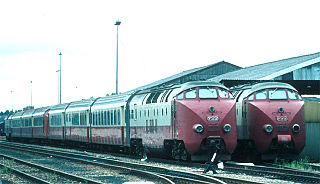
The SBB-CFF-FFS RAm TEE I and NS DE4 were a class of five 4-car diesel-electric trainsets ordered for Trans Europe Express (TEE) service. Two were ordered by the Swiss Federal Railways (SBB-CFF-FFS) and three by Nederlandse Spoorwegen (NS)
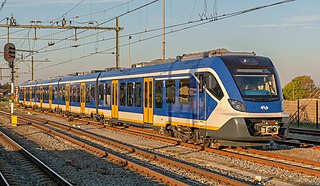
The Sprinter New Generation (SNG) is an electrically driven type of trainset of the Dutch Railways or Nederlandse Spoorwegen. The trains are designed and built by the Spanish train builder Construcciones y Auxiliar de Ferrocarriles (CAF), who bases the trains on the Civity platform. The trains are primarily intended to replace older train equipment, but are also intended for the growth of the number of passengers on the Hoofdrailnet or main rail network.

The Mat '24 was a series of electric "locomotives" of the Dutch Railways. After the arrival of electric streamline units in 1935, the name of this equipment became Blokkendozen, after the angular model. Some NS employees and those interested in the railway invariably spoke of "(electric) buffer equipment", to distinguish it from the streamlined, bufferless electric multiple units of the types Mat '35, Mat '36 and Mat '40.




















